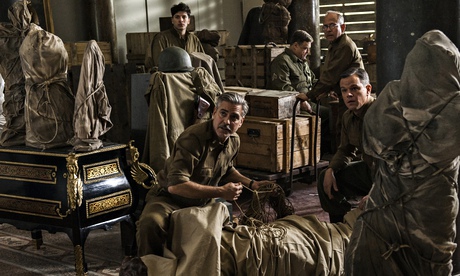
Monuments Men (2014)
Director: George Clooney
Entertainment grade: C
History grade: B
The Monuments, Fine Arts and Archives programme was a group of men and women in the Allied armies who protected and preserved treasures during the second world war, and later found and returned art stolen by the Nazis.
Art
It's March 1943. Belgian monks hide their altarpieces, a swastika flag flutters in front of the Eiffel Tower, and Adolf Hitler is pilfering art from all over Europe to build a collection for his planned Führermuseum. Meanwhile, in the US, museum curator Frank Stokes (George Clooney) tries to persuade American commanders that European art is worth saving. "This is Da Vinci's Last Supper," he says, showing them a slide. A poor start. It's actually Leonardo's Last Supper; Da Vinci is not Leonardo's surname. Vinci was the town he came from. Calling him "Da Vinci" is like saying "of Nazareth" instead of Jesus or "of Troy" instead of Helen. No museum curator worth their salt has ever called him Da Vinci, especially not in 1943. The error became common only after Dan Brown made it 60 years later in the title of his bestselling novel, The Da Vinci Code.
People
Stokes assembles a crack team of mostly older gentlemen, including architect Richard Campbell (Bill Murray) and sculptor Walter Garfield (John Goodman), plus a couple of younger ones like James Granger (Matt Damon), whose exemption from normal military draft is vaguely waved away. All these characters are fictionalised, but they are based on real people: Frank Stokes is modelled on George Stout; Campbell on Robert K. Posey; Garfield on Walker Hancock; Granger on James Rorimer. The action skips to July 1944, and they head over to the liberated bit of France and towards Paris. The action skips again to December 1944 and the Battle of the Bulge. If you're getting the sense that the film is episodic and poorly structured, unfortunately you'd be right.
Characters
There are far too many characters, so the screenplay splits them up into little groups and sends them off on various errands. Some of these are more exciting than others – but they do not add up to a satisfying plot. A TV series might have been a better vehicle for the "monuments men" stories than a feature film. Skimming too lightly over too much material, the movie frequently loses its way. In the discordant Battle of the Bulge scene, you're supposed to be moved by Campbell listening to a record sent by his wife – or some woman he likes, anyway – of her singing Have Yourself a Merry Little Christmas. Bill Murray does his usual stalwart job of looking hangdog, but it's impossible to get emotional about it as a viewer. You have no idea of his back story, you haven't heard anything about this woman or his family, and if you're a historian you might be thinking: "Hang on, Have Yourself a Merry Little Christmas was first sung by Judy Garland in Meet Me in St Louis, which was released in the US on 28 November 1944. So would his wife really have had time to learn the song, record it, send it from the US through the intercontinental army postage system to a battlefield in the Ardennes by mid-December?" And that's how being a pedant ruins everyone's Christmas.
Theft
The closest thing the film has to a narrative drive is its story about SS officer Viktor Stahl (Justus von Dohnányi) biffing off with a load of masterpieces, and then masquerading as an ordinary peasant with a cottage full of "fakes". The monuments men find him thanks to a remarkable coincidence: one of them has toothache, and his talkative dentist is Stahl's father-in-law. This story is actually true, more or less as depicted in the film. The real SS agent in question was one Hermann Bunjes, who hanged himself in prison in 1945. In real life, Bunjes led the men to the mines where the Nazis stashed much of their loot. The film adds a twist: the retreating SS burn Raphael's Portrait of a Young Man, which was indeed stolen by the Nazis but in fact may well still exist.
Tension
Finally, the monuments men must rush to liberate Jan and Hubert van Eyck's Ghent altarpiece and Michelangelo's Madonna of Bruges from a mine before the Soviets arrive and nick all the art for themselves. In fact, the Ghent altarpiece and the Madonna were recovered at leisure from the Altaussee salt mine, not bundled away in a panic. But there would, by this point, be no tension left in the limp narrative whatsoever if the film didn't manufacture some sort of peril. Hence the Soviets, complete with a commander whose job it seems to be to stand around looking like the kind of guy who really, really wants to steal himself a 15th-century Flemish polyptych altarpiece. If he was allowed to say a line to the Americans, it would be: "Even though I am your ally, you can wheel me on at the end to help you strike a cheap note of triumphalism."
Verdict
The story is fascinating, but this film's good intentions are hampered by its lack of pace, direction, tone and properly fleshed-out characters.
• Ten things we learned from George Clooney's Reddit AMA

